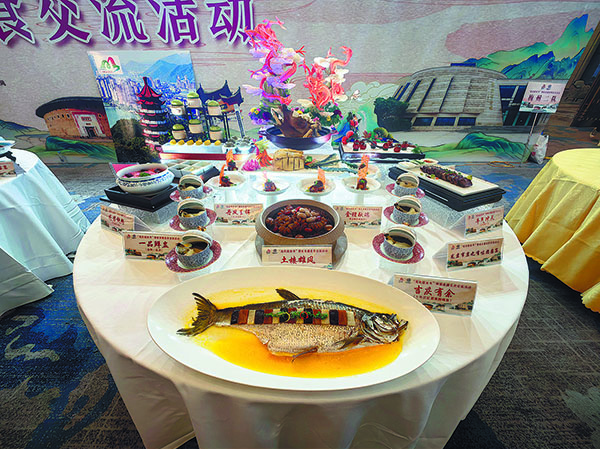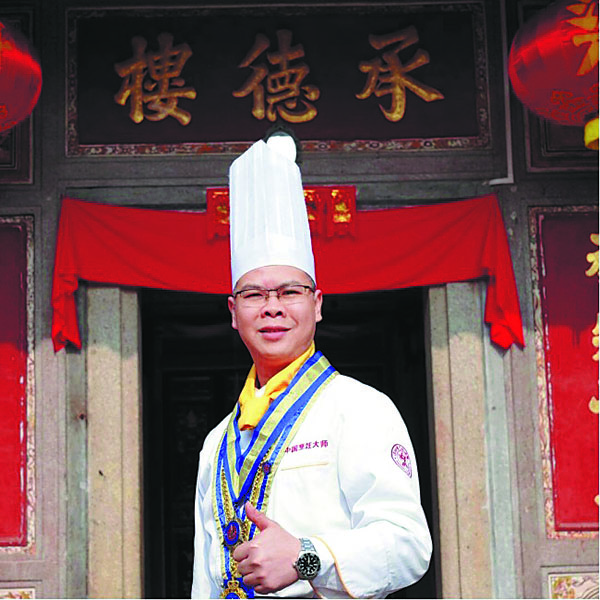

Hakka cuisine was on the menu at an event in Longyan, Fujian province, to mark the Year of the Dragon. Eight master chef teams from Longyan and Sanming in Fujian, Meizhou in Guangdong province, and Ganzhou in Jiangxi province, competed at the "Longyan welcomes the Year of the Loong" (as the dragon is called in Chinese) Hakka cuisine exchange. Each team presented 10 dishes that offered a glimpse into the rich and diverse culinary heritage of the Hakka people.
Chef Huang Chonghui from Longyan presented a platter of western Fujian Hakka snacks made from ingredients like Chinese mugwort leaves and chestnut.
The chef was quick to highlight the historical significance of the cuisine. "Hakka cuisine emphasizes the use of ample oil and salt, which was essential during migration, thus giving Hakka dishes a rich, salty and fragrant characteristic," Huang says.
Chen Zehuan, who represented Meizhou, pointed out the tradition's resourcefulness and adaptability, which incorporates a wide variety of ingredients and cooking techniques passed down through generations.
"Poultry and meats were usually processed and preserved in salt, making them easier to store and transport," Chen says, reflecting on the historical challenges the Hakka people faced during their migration from Central China to the south.
One of Chen's specialties, salt-baked chicken, embodies traditional cooking methods and is known for its rich flavor, tender meat and appetizing golden hue.
Chen says his involvement in the three-day event reinforced his commitment to promoting Hakka cuisine as a formidable culinary tradition, and will encourage him to develop more signature dishes.

Longyan, which is known as one of the ancestral Hakka lands and a cradle of its cuisine, has been making significant efforts in recent years to develop and promote Hakka dishes.
Salt-baked chicken is one signature dish, as are stuffed tofu, pork with preserved vegetable, and Poon Choi, which means "basin dish", in which meat, seafood and vegetables are piled up in a basin.
"We aim to establish Hakka cuisine as the ninth major Chinese cuisine, and to position Longyan as a renowned city for Hakka cuisine," says Shen Dexing, deputy director of the city's culture and tourism bureau.
Centering on these two goals, Longyan is working to create a brand identity, on publicity and promotion of Hakka cuisine, and on the development of convenient ready-to-cook dishes.
The city has hosted several of the competitions since 2022.
This year's event was organized by the Fujian provincial department of culture and tourism and the government of Longyan, with the support of tourism departments from Meizhou, Ganzhou and Sanming.
During the first Hakka intangible heritage food culture academic exchange meeting on Jan 16 in Longyan, experts discussed the potential for the cuisine to be recognized as the ninth major Chinese cuisine alongside Anhui, Cantonese, Fujian, Hunan, Jiangsu, Shandong, Sichuan and Zhejiang cuisines.
Chen Xuanzhang, head of the Fujian-Taiwan Hakka Research Institute, Longyan University, emphasized the tradition's unique nature, noting that it retained traditional cooking techniques and flavors while integrating the ingredients from areas of Hakka migration and incorporating innovative culinary theories.
"Hakka cuisine is usually regarded as a branch of existing traditions rather than as an independent entity," Chen Xuanzhang says.
He says that Hakka dishes are currently made in many provinces, such as Fujian, Guangdong, Jiangxi and Zhejiang, as well as in Hong Kong, Macao and Taiwan, and in places the Hakka have migrated to.
"Overall, Hakka cuisine seeks to preserve the original flavor, with unique techniques to preserve the nutrition and original taste of the food that emphasize freshness, authenticity and richness," he says.
Chen Wen, chairman of the western Fujian Hakka cuisine culture and industry promotion association, stresses the importance of clarifying definitions and descriptions to support the spread of the Hakka cuisine, such as what Hakka cuisine is, what its basic characteristics are, and how it differs in various regions.
"Hakka dishes have different characteristics in different regions, but the culture behind them is the same," he says.
"We can emphasize the underlying cultural unity and allow the world to fall in love with Hakka taste," he says.